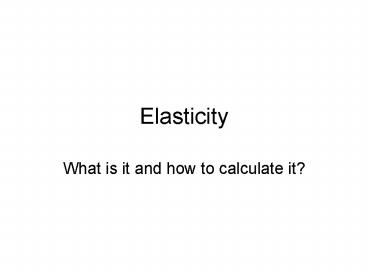Elasticity PowerPoint PPT Presentation
1 / 35
Title: Elasticity
1
Elasticity
- What is it and how to calculate it?
2
The Concept of Elasticity
- Elasticity is a measure of the responsiveness of
one variable to another. - The greater the elasticity, the greater the
responsiveness.
3
Laugher Curve
- Q. Whats the difference between an economist
and a befuddled old man with Alzheimers? - A. The economist is the one with a calculator.
4
The Concept of Elasticity
- Elasticity is a measure of the responsiveness of
one variable to another. - The greater the elasticity, the greater the
responsiveness.
5
Price Elasticity
- The price elasticity of demand is the percentage
change in quantity demanded divided by the
percentage change in price.
6
Price Elasticity
- The price elasticity of supply is the
proportional change in quantity demanded relative
to the proportional change in price.
7
What Information Price Elasticity Provides
- Price elasticity of demand and supply gives the
exact quantity response to a change in price.
8
Classifying Demand and Supply as Elastic or
Inelastic
- Demand or supply is elastic if the percentage
change in quantity is greater than the percentage
change in price. - E gt 1
9
Classifying Demand and Supply as Elastic or
Inelastic
- Demand or supply is inelastic if the percentage
change in quantity is less than the percentage
change in price.
E lt 1
10
Elastic Demand and Supply
- Elastic supply means that quantity changes by a
greater percentage than the percentage change in
price. - The same holds true for demand.
11
Inelastic Demand and Supply
- Inelastic supply means that quantity doesn't
change much with a change in price. - The same holds true for demand.
12
Elasticity Is Independent of Units
- Percentages allow us to have a measure of
responsiveness that is independent of units. - This makes comparisons of responsiveness of
different goods easier.
13
Calculating Elasticities
- To determine elasticity divide the percentage
change in quantity by the percentage change in
price.
14
The End-Point Problem
- The end-point problem the percentage change
differs depending on whether you view the change
as a rise or a decline in price.
15
The End-Point Problem
- Economists use the average of the end points to
calculate the percentage change.
16
Graphs of Elasticities
Elasticity of demand between A and B 1.27
17
Graphs of Elasticities
Elasticity of supply between A and B 0.18
18
Calculating Elasticity
19
Calculating Elasticity of Demand Between Two
Points
Elasticity of demand between A and B
26
B
24
22
midpoint
C
Price
20
A
18
16
Demand
14
0
10
12
14
Quantity of software (in hundred thousands)
20
Calculating Elasticity of Supply Between Two
Points
6.00
5.50
Elasticity of supply between A and B
5.00
B
C
4.50
Wage per hour
A
4.00
3.50
3.00
0
470
480
490
Quantity of workers
21
Calculating Elasticity at a Point
- Let us now turn to a method of calculating the
elasticity at a specific point, rather than over
a range or an arc.
22
Calculating Elasticity at a Point
- To calculate elasticity at a point, determine a
range around that point and calculate the arc
elasticity.
23
Calculating Elasticity at a Point
24
Calculating Elasticity at a Point
To calculate elasticity at a point determine a
range around that point and calculate the arc
elasticity.
25
Elasticity and Supply and Demand Curves
- Two important points to consider
- Elasticity is related (but is not the same as)
slope. - Elasticity changes along straight-line demand and
supply curves.
26
Calculating Elasticity at a Point
10
Demand
9
Supply
EA 2.33
8
7
6
Price
5
ED 0.86
4
3
EB 0.11
EC 0.75
2
1
6
12
18
30
36
42
48
Quantity
24
60
54
27
Elasticity and Supply and Demand Curves
- Two important points to consider
- Elasticity is related (but is not the same as)
slope. - Elasticity changes along straight-line demand and
supply curves.
28
Elasticity Is Not the Same as Slope
- The steeper the curve at a given point, the less
elastic is supply or demand. - There are two limiting examples of this.
29
Elasticity Is Not the Same as Slope
- When the curves are flat, we call the curves
perfectly elastic.
- The quantity changes enormously in response to a
proportional change in price (E ).
30
Elasticity Is Not the Same as Slope
- When the curves are vertical, we call the curves
perfectly inelastic.
- The quantity does not change at all in response
to an enormous proportional change in price (E
0).
31
Perfectly Inelastic Demand Curve
32
Perfectly Elastic Demand Curve
33
Elasticity Changes Along Straight-Line Curves
- Elasticity is not the same as slope.
- Elasticity changes along straight line supply and
demand curvesslope does not.
34
Elasticity Along a Demand Curve
Ed 8
Elasticity declines along demand curve as we move
toward the quantity axis
10
9
8
7
6
Ed 1
Price
5
4
3
2
1
0
1
2
3
4
5
6
7
8
9
10
Quantity
35
Elasticity Along a Supply Curve
S0
If the supply curve intersects the vertical axis,
Es declines as you go up the supply curve.
S1
10
Es declines
9
8
7
6
Es ?
Price
5
Es rises
4
If the supply curve intersects the quantity axis,
Es increases as you go up the supply curve.
3
2
1
0
0
1
2
3
4
5
6
7
Quantity

